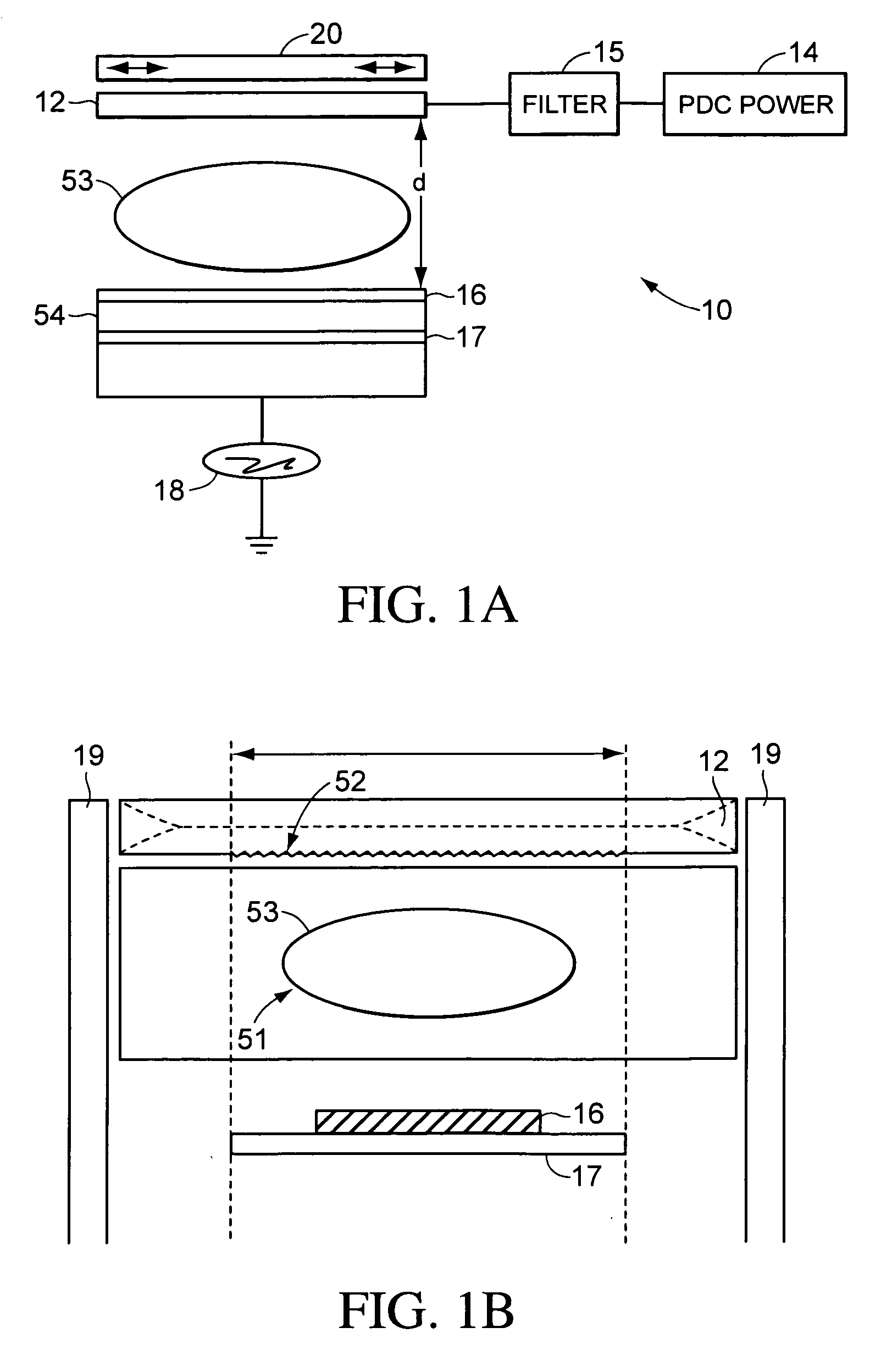Biased pulse DC reactive sputtering of oxide films
a technology of reactive sputtering and oxide films, applied in the direction of instruments, optical elements, vacuum evaporation coatings, etc., can solve the problems of difficult control of uniformity of doping in cvd processes, phosphorous and boron are hygroscopic, and alkalis are undesirable for integration with electronic devices
- Summary
- Abstract
- Description
- Claims
- Application Information
AI Technical Summary
Benefits of technology
Problems solved by technology
Method used
Image
Examples
example 1
[0114] An AKT 1600 based reactor can be utilized to deposit a film. In this example, a wide area metallic target of dimension 550×650 mm with composition (Si / Al / Er / Yb) being about 57.0 cat. % Si, 41.4 cat. % Al, 0.8 cat. % Er, and 0.8 cat. % Yb (a “0.8 / 0.8” target) was fabricated as described in the '247 patent.
[0115] In step 402, a 150 mm P-type silicon wafer substrate was placed in the center of a 400×500 mm glass carrier sheet 17. Power supply 14 was set to supply 6000 watts of pulse DC power at a frequency of 120 KHz with a reverse pulsing time of about 2.3 us. Magnet 20, which is a race-track shaped magnet of approximate dimension 150 mm×600 mm, was swept over the backside of the target at a rate of about 4 seconds per one-way scan. The temperature of substrate 16 was held at 200 C and 100W of 2 MHz RF power was applied to substrate 16. The target 12 to substrate 16 distance was about 6.5 cm. The sputtering gas was a mixture of Argon and Oxygen. Substrate 16 and carrier 17 was...
example 2
[0121] A waveguide amplifier can be deposited according to the present invention. An embodiment of target 12 having composition 57.4 cat. % Si, 41.0 cat. % Al, 0.8 cat. % Er 0.8 cat. % Yb (the “0.8 / 0.8 target”) can be formed as disclosed in the '245 application. The Er—Yb (0.8 / 0.8) co-doped Alumino-Silicate film was deposited onto a 6 inch wafer of substrate 16 which includes a 10 μm thick thermal oxide substrate, which can be purchased from companies such as Silicon Quest International, Santa Clara, Calif. Target 12 was first cleaned by sputtering with Ar (80 sccm) only in the metallic mode. Target 12 was then conditioned in poison mode by flowing 60 sccm of Argon and 40 sccm of oxygen respectively. The power supplied to target 12 during conditioning was kept at about 6 kW.
[0122] An active core film was then deposited on substrate 16. The thickness of the deposited film is approximately 1.2 μm. The deposition parameters are shown in Table 2.
TABLE 2TargetPulsingReversePowerAr / O2F...
example 3
[0125] This example describes production of a dual core Erbiurn / Yttrbium co-doped amplifier according to the present invention. In one example, substrate 16 is a silicon substrate with an undercladding layer of thermally oxidized SiO2 of about 15 μm thick. Substrate 16 with the thermal oxide layer can be purchased from companies such as Silicon Quest International, Santa Clara, Calif. A layer of active core material is then deposited on substrate 16 with a Shadow Mask as described in the '138 application. Use of a shadow mask results in a vertical taper on each side of a finished waveguide which greatly enhances the coupling of light into and out of the waveguide.
[0126] Active core layer is deposited from a 0.8 / 0.8 target as described in the '247 application having composition 57.4 cat. % Si, 41.0 cat. % Al, 0.8 cat. % Er, and 0.8 cat. % Yb. The deposition parameters are identical to that of Example 2 described above. The active layer is deposited to a thickness of about 1.2 μm.
[0...
PUM
 Login to View More
Login to View More Abstract
Description
Claims
Application Information
 Login to View More
Login to View More - R&D
- Intellectual Property
- Life Sciences
- Materials
- Tech Scout
- Unparalleled Data Quality
- Higher Quality Content
- 60% Fewer Hallucinations
Browse by: Latest US Patents, China's latest patents, Technical Efficacy Thesaurus, Application Domain, Technology Topic, Popular Technical Reports.
© 2025 PatSnap. All rights reserved.Legal|Privacy policy|Modern Slavery Act Transparency Statement|Sitemap|About US| Contact US: help@patsnap.com



